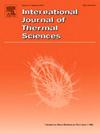Effect of sub-atmospheric pressure on combustion and pyrolysis behavior of flame-retardant polyethylene
IF 5
2区 工程技术
Q1 ENGINEERING, MECHANICAL
International Journal of Thermal Sciences
Pub Date : 2025-05-29
DOI:10.1016/j.ijthermalsci.2025.110028
引用次数: 0
Abstract
With the rapid increase in the number of cruise aircraft and high-altitude greenhouses, internal electrical cables and polyethylene films are often exposed to low-pressure environments. However, current flame-retardant designs for polyethylene do not sufficiently account for the effects of low-pressure conditions, under which the combustion behavior and flame-retardant effectiveness may change significantly, leading to a considerable risk of functional failure. This study systematically investigates the combustion and pyrolysis mechanisms of low-density polyethylene (LDPE) with varying intumescent flame retardant (FR) contents in a pressure range of 55 kPa–101 kPa. The findings reveal that FR significantly enhances char formation under sub-atmospheric pressures, reducing ignition time compared to pure LDPE. Decreased pressure leads to a marked increase in heat release rate (HRR) and a reduction in CO emissions, as measured by a cone calorimeter in a low-pressure chamber. Synchrotron vacuum ultraviolet photoionization mass spectrometry (SVUV-PIMS) further reveals that low-pressure promotes the generation of more alkene and a higher proportion of long-chain pyrolysis products. Intumescent FR effectively reduce HRR, decrease CO production, and minimize the formation of saturated hydrocarbons under low-pressure conditions, while enhancing the char formation. Among these, a 35 wt% FR shows the best performance. However, ammonium polyphosphate, a common flame retardant, tends to make the material more susceptible to ignition. This work enhances the understanding of fire dynamics in low-pressure environments and provides a scientific foundation for designing safer, flame-retardant polyethylene materials tailored for sub-atmospheric applications.

亚大气压对阻燃聚乙烯燃烧热解行为的影响
随着巡航飞机和高空温室数量的迅速增加,内部电缆和聚乙烯薄膜经常暴露在低压环境中。然而,目前的聚乙烯阻燃设计没有充分考虑低压条件的影响,在低压条件下,燃烧行为和阻燃效果可能会发生显著变化,导致相当大的功能失效风险。本文系统研究了不同膨胀阻燃剂含量的低密度聚乙烯(LDPE)在55 kPa - 101 kPa压力范围内的燃烧热解机理。研究结果表明,与纯LDPE相比,FR显著提高了亚大气压下炭的形成,缩短了点火时间。压力的降低导致热释放率(HRR)的显著增加和CO排放量的减少,这是用低压室中的锥形量热计测量的。同步加速器真空紫外光电离质谱(SVUV-PIMS)进一步揭示,低压有利于烯烃的生成和长链热解产物比例的提高。膨胀FR有效降低了HRR,降低了CO产量,在低压条件下最大限度地减少了饱和烃的形成,同时促进了焦炭的形成。其中,FR为35 wt%时表现最佳。然而,聚磷酸铵,一种常见的阻燃剂,往往使材料更容易着火。这项工作增强了对低压环境下火灾动力学的理解,为设计更安全、阻燃的亚大气压聚乙烯材料提供了科学基础。
本文章由计算机程序翻译,如有差异,请以英文原文为准。
求助全文
约1分钟内获得全文
求助全文
来源期刊

International Journal of Thermal Sciences
工程技术-工程:机械
CiteScore
8.10
自引率
11.10%
发文量
531
审稿时长
55 days
期刊介绍:
The International Journal of Thermal Sciences is a journal devoted to the publication of fundamental studies on the physics of transfer processes in general, with an emphasis on thermal aspects and also applied research on various processes, energy systems and the environment. Articles are published in English and French, and are subject to peer review.
The fundamental subjects considered within the scope of the journal are:
* Heat and relevant mass transfer at all scales (nano, micro and macro) and in all types of material (heterogeneous, composites, biological,...) and fluid flow
* Forced, natural or mixed convection in reactive or non-reactive media
* Single or multi–phase fluid flow with or without phase change
* Near–and far–field radiative heat transfer
* Combined modes of heat transfer in complex systems (for example, plasmas, biological, geological,...)
* Multiscale modelling
The applied research topics include:
* Heat exchangers, heat pipes, cooling processes
* Transport phenomena taking place in industrial processes (chemical, food and agricultural, metallurgical, space and aeronautical, automobile industries)
* Nano–and micro–technology for energy, space, biosystems and devices
* Heat transport analysis in advanced systems
* Impact of energy–related processes on environment, and emerging energy systems
The study of thermophysical properties of materials and fluids, thermal measurement techniques, inverse methods, and the developments of experimental methods are within the scope of the International Journal of Thermal Sciences which also covers the modelling, and numerical methods applied to thermal transfer.
 求助内容:
求助内容: 应助结果提醒方式:
应助结果提醒方式:


